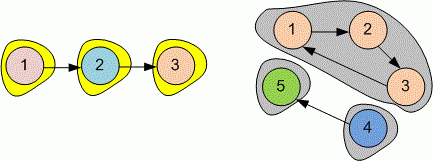Editorial
Find the number of strongly connected components in the directed graph.
Example
Graphs, given in samples, have the form:

Each of these graphs has strongly connected components.
Algorithm realization
The input graph is stored in the adjacency list . The inverse graph is stored in the adjacency list .
vector<vector<int> > g, gr; vector<int> used, top;
The function dfs1 implements depth-first search on the input graph. It adds vertices to the array in the order in which the depth-first search finishes processing them.
void dfs1(int v)
{
used[v] = 1;
for (int to : g[v])
if (!used[to]) dfs1(to);
top.push_back(v);
}The function dfs2 implements depth-first search on the reversed graph. All vertices traversed during a recursive call of dfs2 belong to one strongly connected component.
void dfs2(int v)
{
used[v] = 1;
for (int to : gr[v])
if (!used[to]) dfs2(to);
}The main part of the program. Read the input data. Construct the reversed graph.
scanf("%d %d", &n, &m);
g.resize(n + 1);
gr.resize(n + 1);
for(i = 1; i <= m; i++)
{
scanf("%d %d",&a,&b);
g[a].push_back(b);
gr[b].push_back(a);
}Run a depth-first search on the input graph. The order in which the vertices finish processing is stored in the array.
used.resize(n+1); for(i = 1; i <= n; i++) if (!used[i]) dfs1(i);
Run a depth-first search on the reversed graph. The vertices of the reversed graph should be processed in the order given by traversing the array from right to left (from end to start). For convenience in further processing, let’s reverse the array .
used.clear(); used.resize(n + 1); reverse(top.begin(), top.end());
Use the variable to count the number of strongly connected components.
c = 0;
Now move through the array from left to right and call dfs2 from each unvisited vertex.
for (int v : top)
if (!used[v])
{
dfs2(v);
c++;
}Print the number of strongly connected components in the graph.
printf("%d\n",c);Java realization
import java.util.*;
public class Main
{
static ArrayList<Integer>[] g, gr;
static boolean used[];
static Vector<Integer> top = new Vector<Integer>();
static void dfs1(int v)
{
used[v] = true;
for(int i = 0; i < g[v].size(); i++)
{
int to = g[v].get(i);
if (!used[to]) dfs1(to);
}
top.add(v);
}
static void dfs2(int v)
{
used[v] = true;
for(int i = 0; i < gr[v].size(); i++)
{
int to = gr[v].get(i);
if (!used[to]) dfs2(to);
}
}
@SuppressWarnings("unchecked")
public static void main(String[] args)
{
Scanner con = new Scanner(System.in);
int n = con.nextInt();
int m = con.nextInt();
g = new ArrayList[n+1];
for(int i = 0; i <= n; i++)
g[i] = new ArrayList<Integer>();
gr = new ArrayList[n+1];
for(int i = 0; i <= n; i++)
gr[i] = new ArrayList<Integer>();
for (int i = 0; i < m; i++)
{
int a = con.nextInt();
int b = con.nextInt();
g[a].add(b);
gr[b].add(a);
}
used = new boolean[n+1];
for(int i = 1; i <= n; i++)
if (!used[i]) dfs1(i);
used = new boolean[n+1];
int c = 0;
for(int i = 1; i <= n; i++)
{
int v = top.get(n-i);
if (!used[v])
{
dfs2(v);
c++;
}
}
System.out.println(c);
con.close();
}
} Python realization
The function dfs1 implements depth-first search on the input graph. It adds vertices to the array in the order in which the depth-first search finishes processing them.
def dfs1(v):
global g, used, top
used[v] = True
for to in g[v]:
if not used[to]: dfs1(to)
top.append(v)The function dfs2 implements depth-first search on the reversed graph. All vertices traversed during a recursive call of dfs2 belong to one strongly connected component.
def dfs2(v):
global gr, used
used[v] = True
for to in gr[v]:
if not used[to]: dfs2(to)The main part of the program. Read the input data. Construct the reversed graph.
n, m = map(int, input().split()) g = [[] for _ in range(n + 1)] gr = [[] for _ in range(n + 1)] for _ in range(m): a, b = map(int, input().split()) g[a].append(b) gr[b].append(a)
Run a depth-first search on the input graph. The order in which the vertices finish processing is stored in the array.
used = [False] * (n + 1) top = [] for i in range(1, n + 1): if not used[i]: dfs1(i)
Run a depth-first search on the reversed graph. The vertices of the reversed graph should be processed in the order given by traversing the array from right to left (from end to start). For convenience in further processing, let’s reverse the array .
used = [False] * (n + 1) top.reverse()
Use the variable to count the number of strongly connected components.
c = 0
Now move through the array from left to right and call dfs2 from each unvisited vertex.
for v in top:
if not used[v]:
dfs2(v)
c += 1Print the number of strongly connected components in the graph.
print(c)